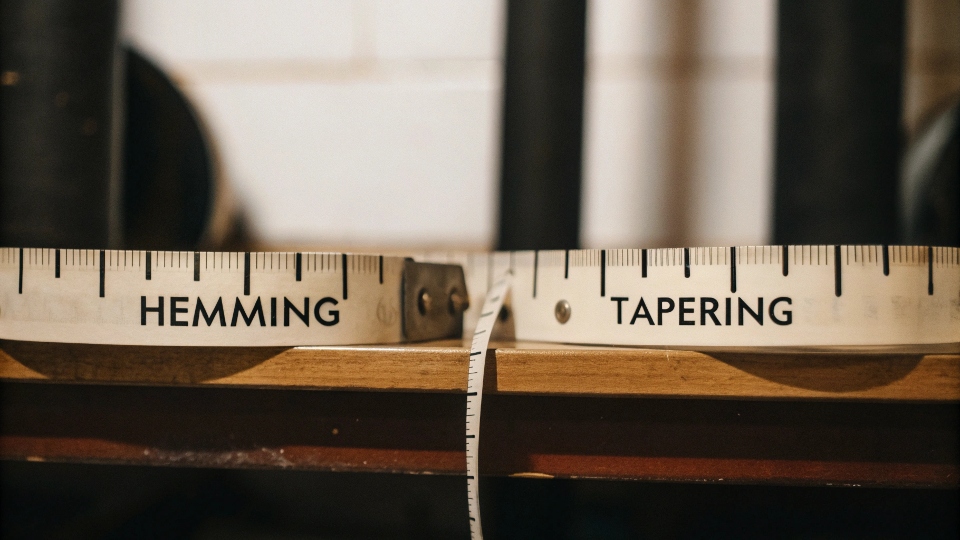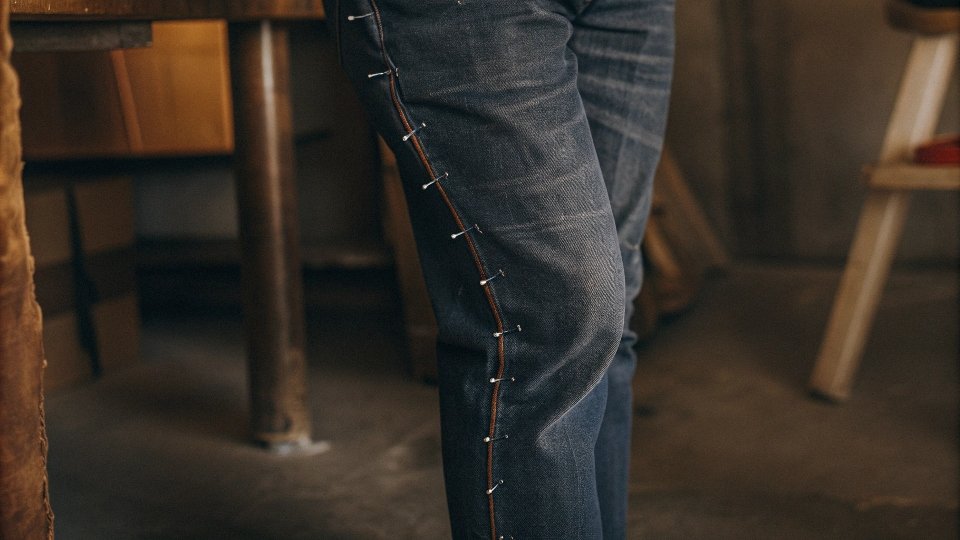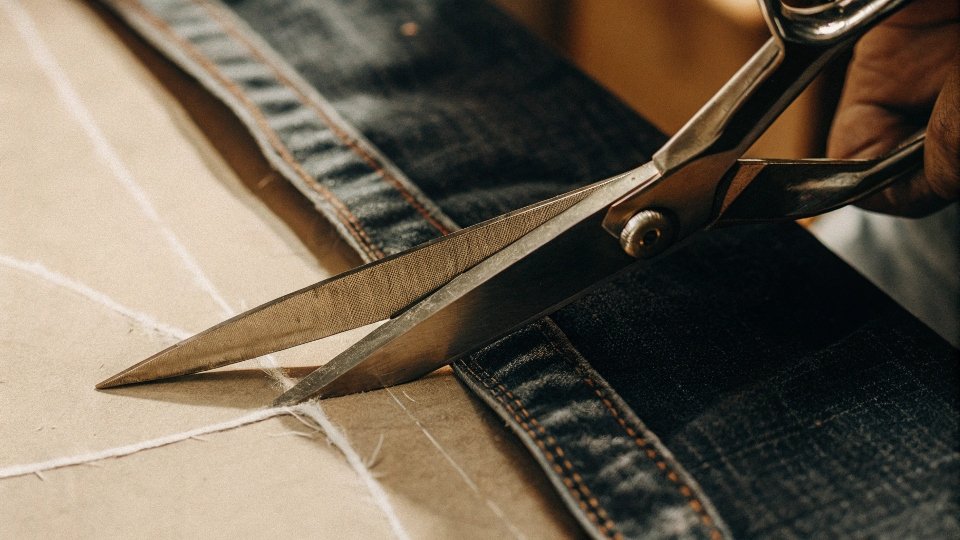Your favorite jeans are just a little too baggy in the legs. You know how to hem, so you wonder if just shortening them will somehow create a slimmer, more modern fit.
No, hemming1 only shortens the length of your jeans; it does not make them skinnier. To reduce the width of the leg for a slimmer fit, you need to taper the seams.
This is one of the most common misunderstandings I've encountered in my 20 years in the denim industry. People often use the word "hem" to describe any alteration, but in the world of clothing manufacturing and tailoring, it means one specific thing: adjusting the length.
A designer like Dean knows that changing the silhouette from bootcut to skinny requires a completely different process called tapering. Let's break down how you can actually achieve that slimmer fit you're looking for, and what to avoid.
How Do You Make Jeans Skinnier?
You love the wash and feel of your jeans, but the leg is just too wide. You want a slimmer silhouette without having to buy a whole new pair.
You can make jeans skinnier using a DIY 'pin-and-sew' method2 along the inseam, or for a guaranteed professional result, you can take them to a tailor for tapering.
In my factory, we create different fits using patterns that are precisely graded. You can replicate this on a smaller scale at home.
The most popular DIY method is to turn your jeans inside out, put them on, and pinch the excess fabric along the inner leg seam until you like the fit. Use safety pins to secure this new line.
Then, take the jeans off carefully, draw a line with chalk along your pins, and sew along that line.
For a less permanent fix, some people use a hair tie looped through the buttonhole and around the button to cinch the waist an inch or two.
However, for a truly flawless result, nothing beats a professional tailor. They can reshape the entire leg evenly, from thigh to ankle, ensuring the fit looks natural and intentional, not like a clumsy home project.
| Method | Best For | Pros | Cons |
|---|---|---|---|
| DIY (Pin & Sew) | Minor adjustments, experienced sewers | Inexpensive, customizable | High risk of uneven seams, difficult on thick denim |
| Professional Tailor | Major reshaping, valuable jeans | Perfect, symmetrical results, preserves original details | Can be costly, requires finding a skilled tailor |
How Do You Hide Tummy Bulge in Jeans?
You have found a pair of jeans that fits your legs perfectly, but it seems to highlight your midsection in a way that makes you uncomfortable and kills your confidence.
To hide a tummy bulge, the best solution is to choose high-rise or mid-rise jeans made with stretch denim3 (1-3% elastane). This combination provides comfortable support and creates a smooth silhouette.
This is a design challenge we focus on constantly. It's not about altering the jeans you have, but about choosing the right design from the start. Low-rise jeans are the biggest enemy here; they sit below the belly and can accentuate a bulge.
A high-rise style, on the other hand, sits at your natural waist, providing coverage and a gentle "holding in" effect. The fabric is just as important. Rigid, 100% cotton denim can feel constricting and can squeeze uncomfortably.
A small amount of elastane4 or spandex allows the fabric to stretch and move with you. It hugs your curves instead of fighting them, which smooths everything out.
You can also use styling to your advantage. Wearing a slightly longer top or layering with an open jacket or cardigan can draw the eye vertically, creating a longer, leaner look.
Can You Tailor Jeans to Be Slimmer?
You have a great pair of high-quality jeans, but they're just a little too loose in the seat or thighs. You're hesitant to take them to a tailor, fearing they'll ruin the original look.
Absolutely. A skilled tailor can expertly make your jeans slimmer. They can take in the waist, slim the thighs, and taper the legs from the knee down for a truly custom fit.
This is the best way to salvage a pair of jeans with a fit that's just "off." When a designer like Dean needs a sample adjusted, he goes to a professional, and you should too. A good tailor who understands denim can do wonders.
They can eliminate that annoying gap at the back of your waistband by taking it in. They can slim down baggy thighs for a more modern silhouette.
Most commonly, they can taper the leg from the knee to the ankle, transforming a straight-leg or bootcut jean into a perfect slim-fit. The key benefit is that a professional will preserve the original details.
They know how to work with thick, flat-felled seams and can often replicate the original chain-stitching5 on the hem, so the alteration looks like it came from the factory.
Just be cautious when tailoring heavily distressed jeans, as altering the shape can make the rips and fades look unnatural.
Will You Ruin Your Jeans if You Cut Them?
You want to give your jeans a trendy raw hem or maybe even try cutting them to make them slimmer. But the fear of one wrong snip turning them into a disaster is very real.
Yes, you can easily ruin your jeans if you cut them without a plan. To do it safely, you must measure carefully, use sharp fabric scissors, and be prepared to sew the new edge.
Cutting denim is an irreversible step, so preparation is everything.
If you're going for a simple raw hem, the risk is lower. The key is to try the jeans on, mark your desired length with chalk, and then cut about an inch below that line.
This extra length will turn into a nice, soft fray after you wash them. However, if you are cutting to change the shape—like slimming the leg—you are performing fabric surgery.
Cutting through the leg without first sewing a new seam inside is a recipe for disaster; the whole leg will just fall open.
Always sew your new seam first, then trim away the excess fabric about a half-inch from your new stitch line.
Never try to cut through thick metal hardware like rivets or buttons. You will ruin both your scissors and your jeans.
Conclusion
Remember, hemming is for length and tapering is for width. To make jeans skinnier, you must alter the seams—a job best handled by a professional tailor for a perfect, factory-quality finish.
-
Understanding hemming is crucial for anyone looking to alter their jeans correctly. ↩
-
Explore this cost-effective method to customize your jeans at home. ↩
-
Understanding stretch denim can help you choose jeans that fit well and feel comfortable. ↩
-
Learn about elastane's role in providing comfort and flexibility in jeans. ↩
-
Discover the importance of chain-stitching for maintaining the integrity of your jeans. ↩



[^4] that smooth the midsection area](https://diznewjeans.com/wp-content/uploads/2025/10/to-hide-a-tummy-bulge-the-best-solution-is-to-c.jpg)
[^6] to expertly alter the seam of a pair of jeans](https://diznewjeans.com/wp-content/uploads/2025/10/absolutely-a-skilled-tailor-can-expertly-make-y.jpg)






